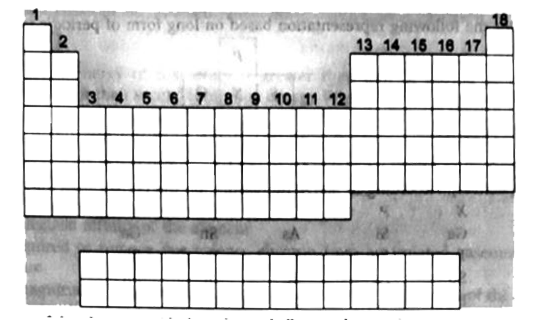Which of the following is not the reason for the higher EA1 of halogens
(I) high nuclear charge (II) larger atomic size
(III) easy to get octet configuration, ns2np6
(IV) half filled p-orbitals The correct answer is
I and IV
I, II and III
II and IV
II and III
The correct Answer is:C
Step by step video, text & image solution for Which of the following is not the reason for the higher EA_(1) of halogens (I) high nuclear charge (II) larger atomic size (III) easy to get octet configuration, ns^(2)np^(6) (IV) half filled p-orbitals The correct answer is by Chemistry experts to help you in doubts & scoring excellent marks in Class 12 exams.
Topper's Solved these Questions
Similar Questions
Answer the following on the basis of modern periodic table.

(I) Group no. of elements with the valence shell ground state electron configuration ns2np5
(II) Group no. of the elements with the valence shell ground state electron configuratio ns2np3
(III) Group no. of the elements that have only three unpaired p electron in ground state
(V) ground 3A elements.View SolutionThe first ionization energy of oxygen is less than that of nitrogen. Which of the following is the correct reason for this observation?
View Solution
Knowledge Check
- Question 1 - Select One
Which of the following are the correct statements
(I) EA of noble gases is endothermic
(II) EA of Fluorine is less than chlorine
(III) EA of oxygen is less than sulphur
(IV) EA of N is more than phosphorous The correct answer isAI,II,III and IVBI, II and IIICII and IVDI and IV - Question 2 - Select One
Which of the following properties of halogens increase with increasing atomic number?
(I) Ionization energy
(II) Ionic radius
(III) Bond energy of the X2 molecule
(IV) Enthalpy of vaporisationAI,II,IIIBI,IIICII,IVDIV - Question 3 - Select One
Which of the following statement is true regarding Bohr's model of hydrogen atom ?
(I) Orbiting speed of electrons decreases as if falls to discrete orbits away from the nucleus.
(II) Radii of allowed orbits of electrons are proportional to the principle quantum number.
(III) Frequency with which electrons orbit around the nucleus in discrete orbits is inversely proportional to the principle quantum number.
(IV) Binding force with which the electron is bound to the nucleus increases as it shifts to outer orbits.
Selected the correct answer using the codes given below:AI and IIIBII and IVCI, II and IIIDII, III and IV
Which of the following pairs is /are correctly matched ?
I. Carbocation : electrophile
II. Free radical : paramagnetic
III. Carbene : Incomplete octet
IV. Carbanion : Incomplete octet
Select the correct answer using the codes given below :View SolutionConsider the following statements .
I. Eu2+ has f7 configuration and it is a strong reducing agent.
II.Yb2+ has f14 configuration and it is a reductant.
III.TbIV has half-filled f-orbitals and is an oxidant.
The correct statement (s)is are (choose the appropriate option )View SolutionEA1 values of the following elements has positive value
(I) Be (II) Br (III) Mg (IV) Cl
The correct answer isView Solutionin an ionic bond the cation tends to polarise the electron cloud of the anion by pulling electron density towards itself This causes development of covalent character in the ionic bond because the electron density gets localised in between the nuclei The tendency of the cation to bring about the polarisation of the anion is expressed as its polasising power The ability of ion to undergo polarisation is called its polarisability The polarising power of a cation or an anion is decided on the basis of F ajans' rules as follows .
(i) The smaller the cation, the higher is its polarising power
(ii) Cations with pseudo-noble gas configuration (ns2np6nd10) have relatively high polarising power than those with noble gas configuration (ns2np6)
(iii) The larger the size of the anion, the higher is its polarisability
Choose the correct order of polarisability for the following
IΘ,BrΘ,CIΘFΘ .View Solutionin an ionic bond the cation tends to polarise the electron cloud of the anion by pulling electron density towards itself This causes development of covalent character in the ionic bond because the electron density gets localised in between the nuclei The tendency of the cation to bring about the polarisation of the anion is expressed as its polasising power The ability of ion to undergo polarisation is called its polarisability The polarising power of a cation or an anion is decided on the basis of F ajans' rules as follows .
(i) The smaller the cation, the higher is its polarising power
(ii) Cations with pseudo-noble gas configuration (ns2np6nd10) have relatively high polarising power than those with noble gas configuration (ns2np6)
(iii) The larger the size of the anion, the higher is its polarisability
Among the following which will have the lowest metlting point and the highest solubility LiCI,BeCI2,BCI3,CCI4 .View Solution

